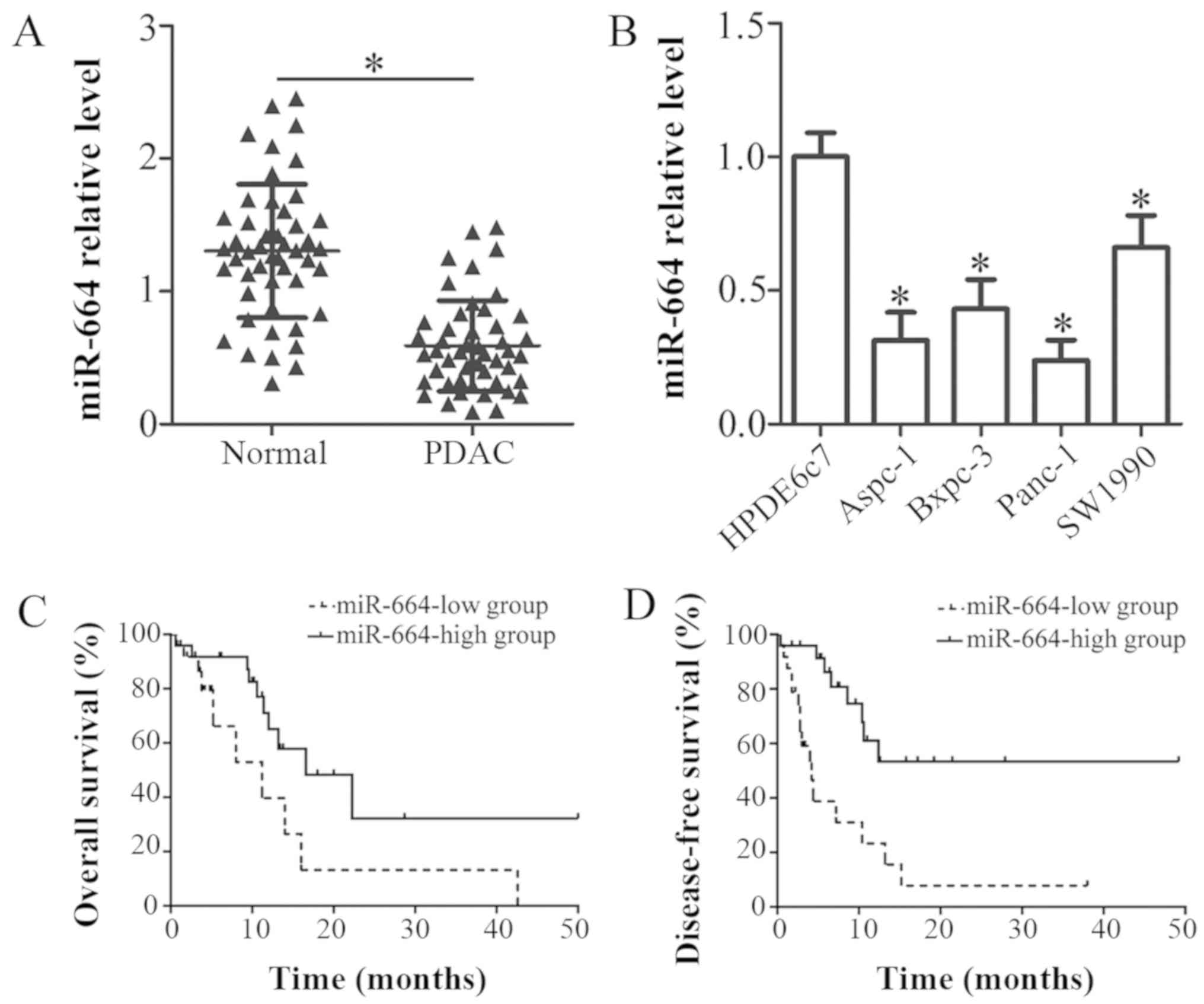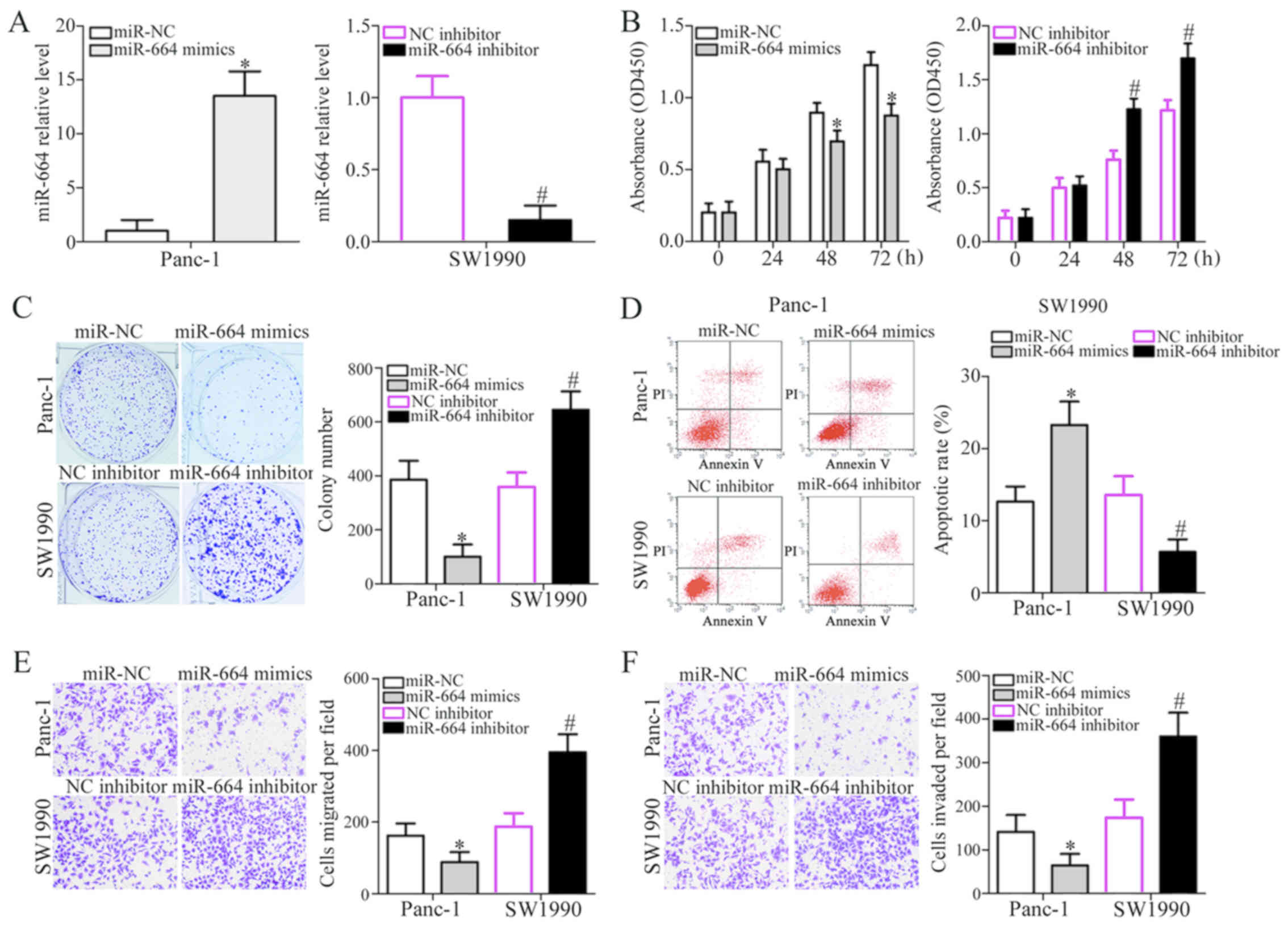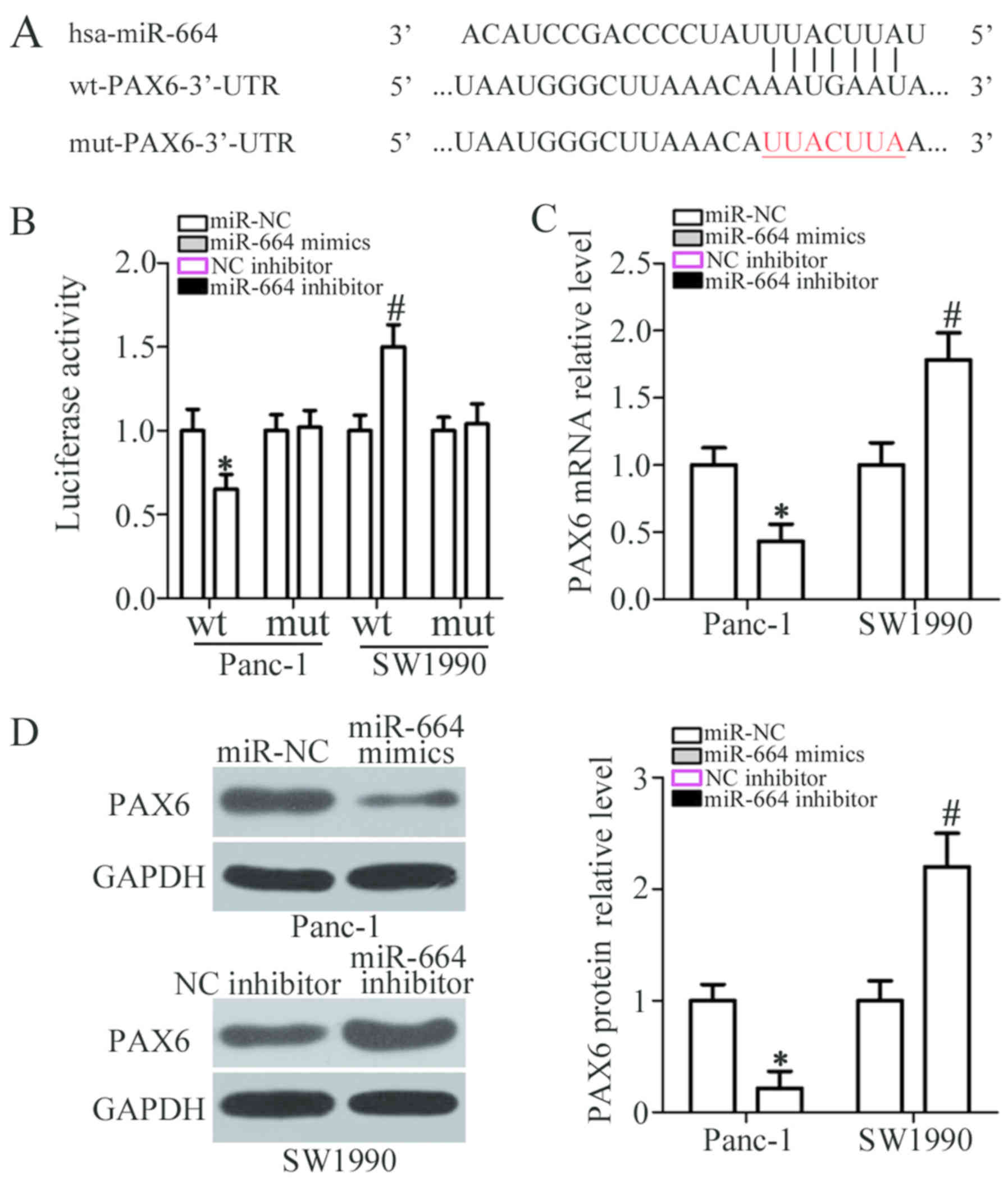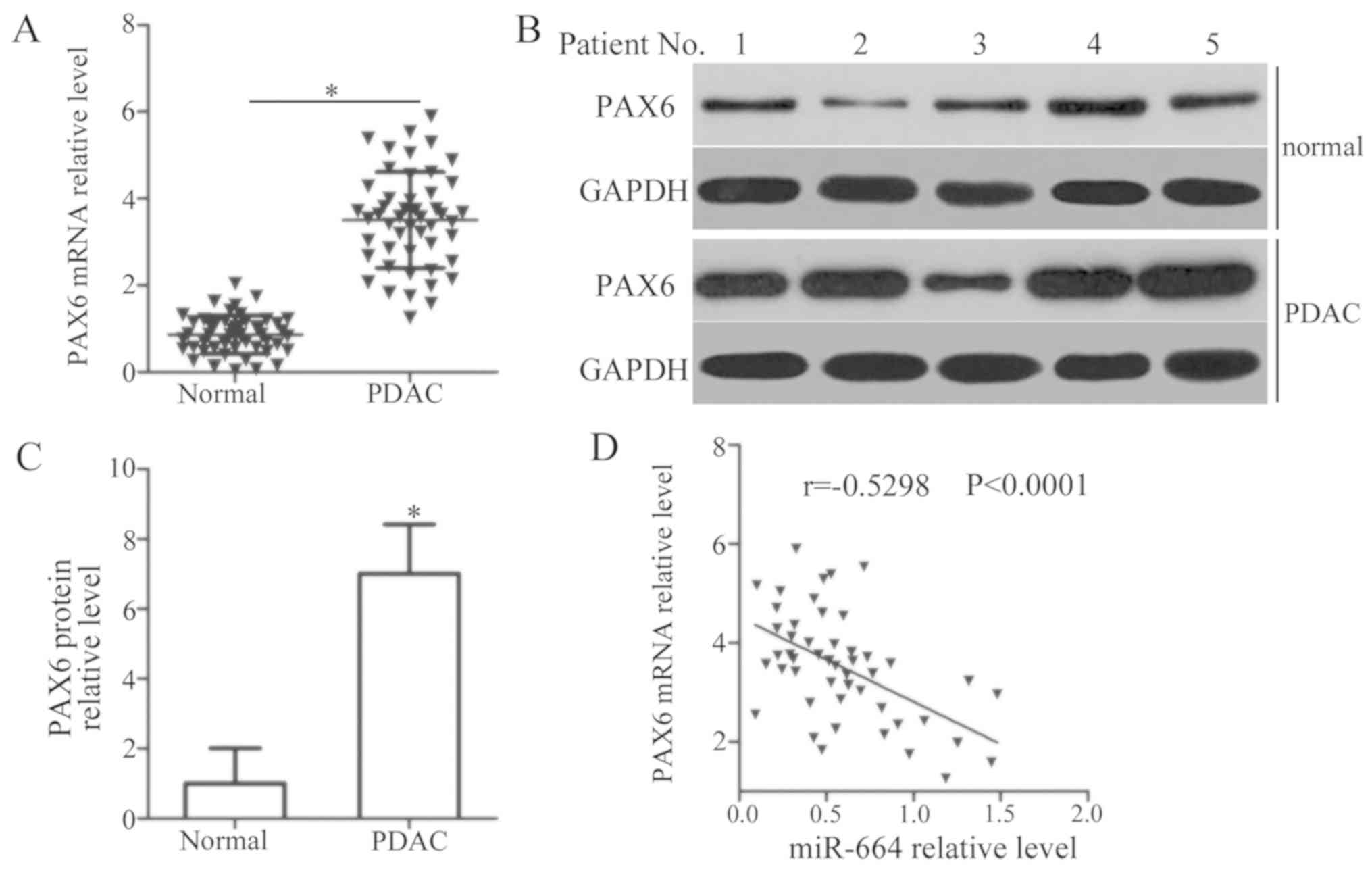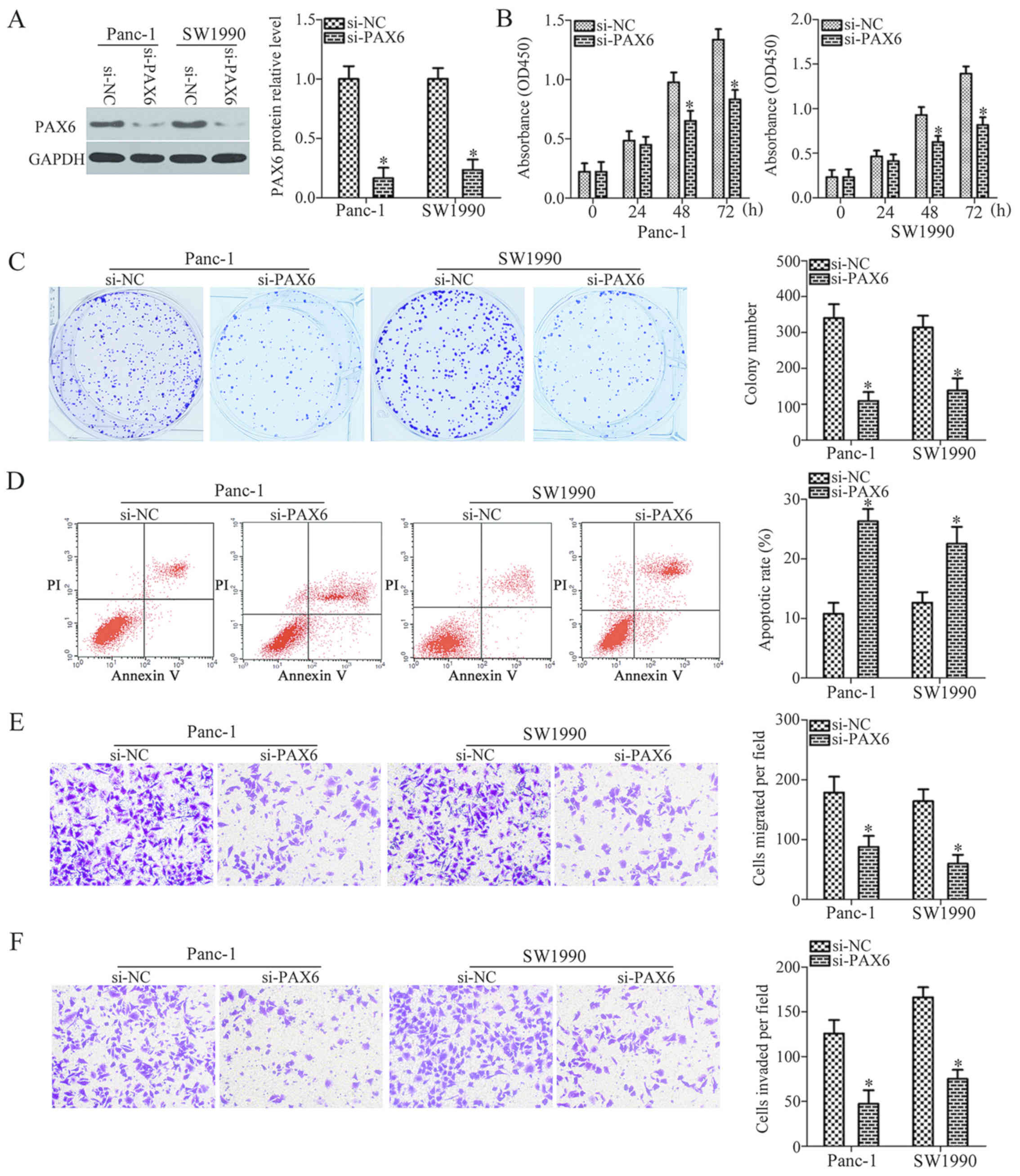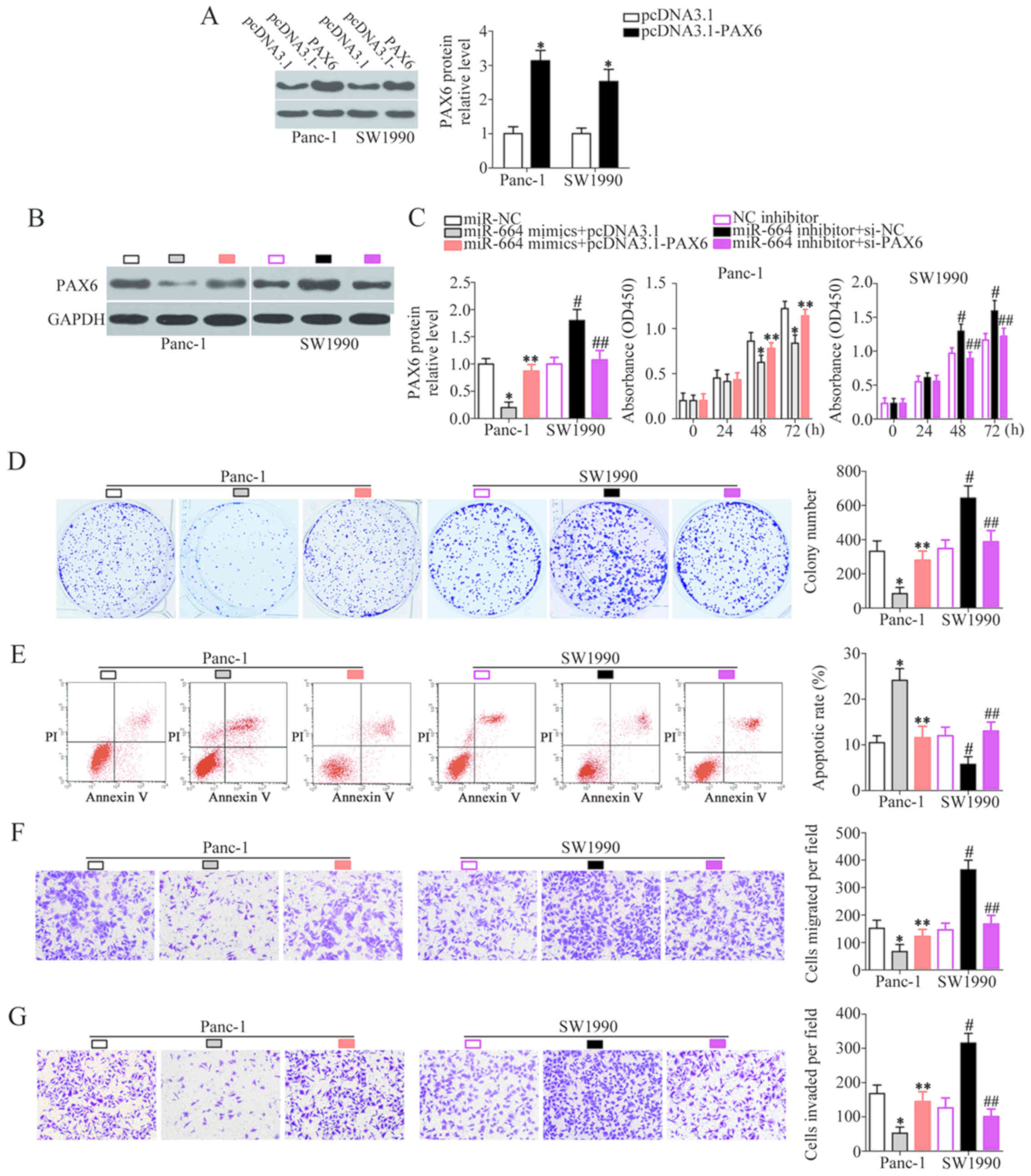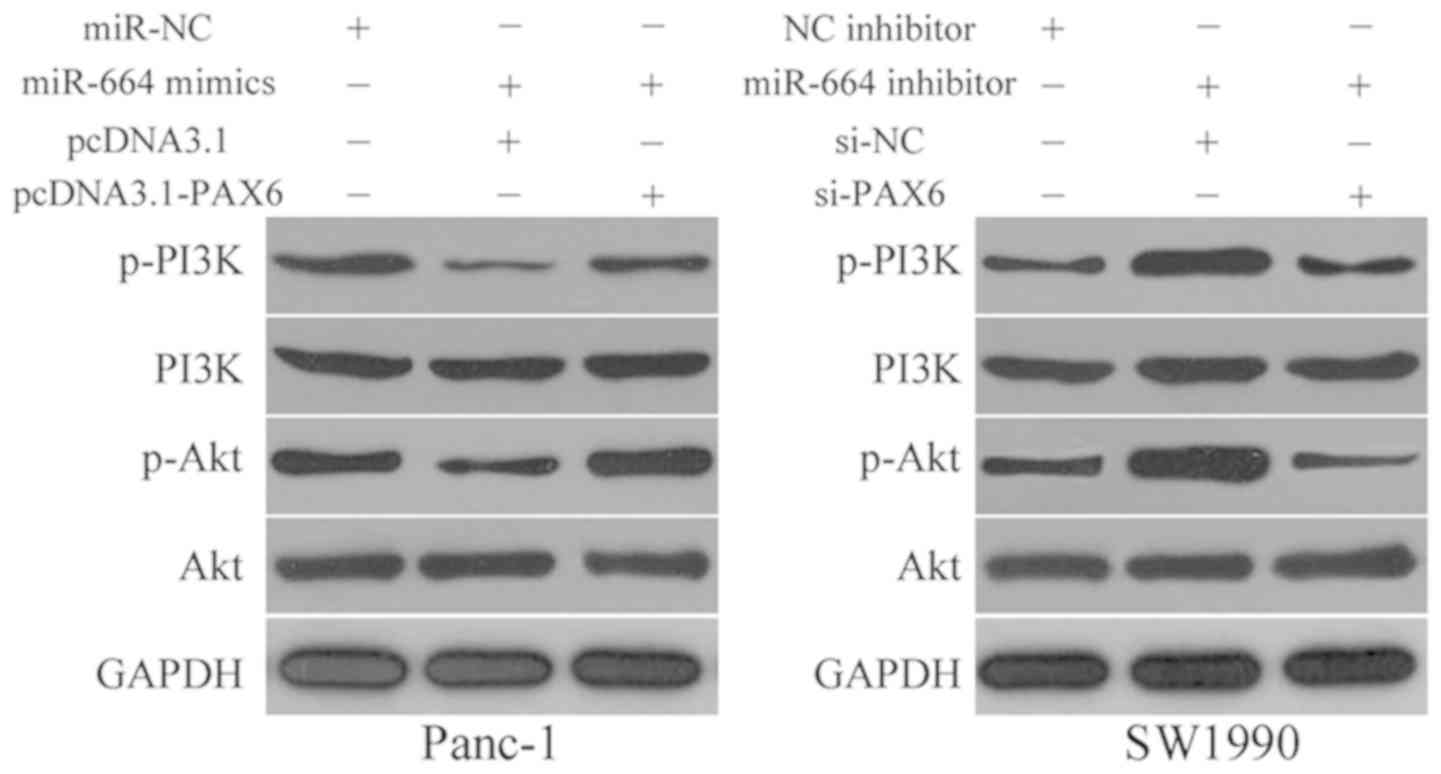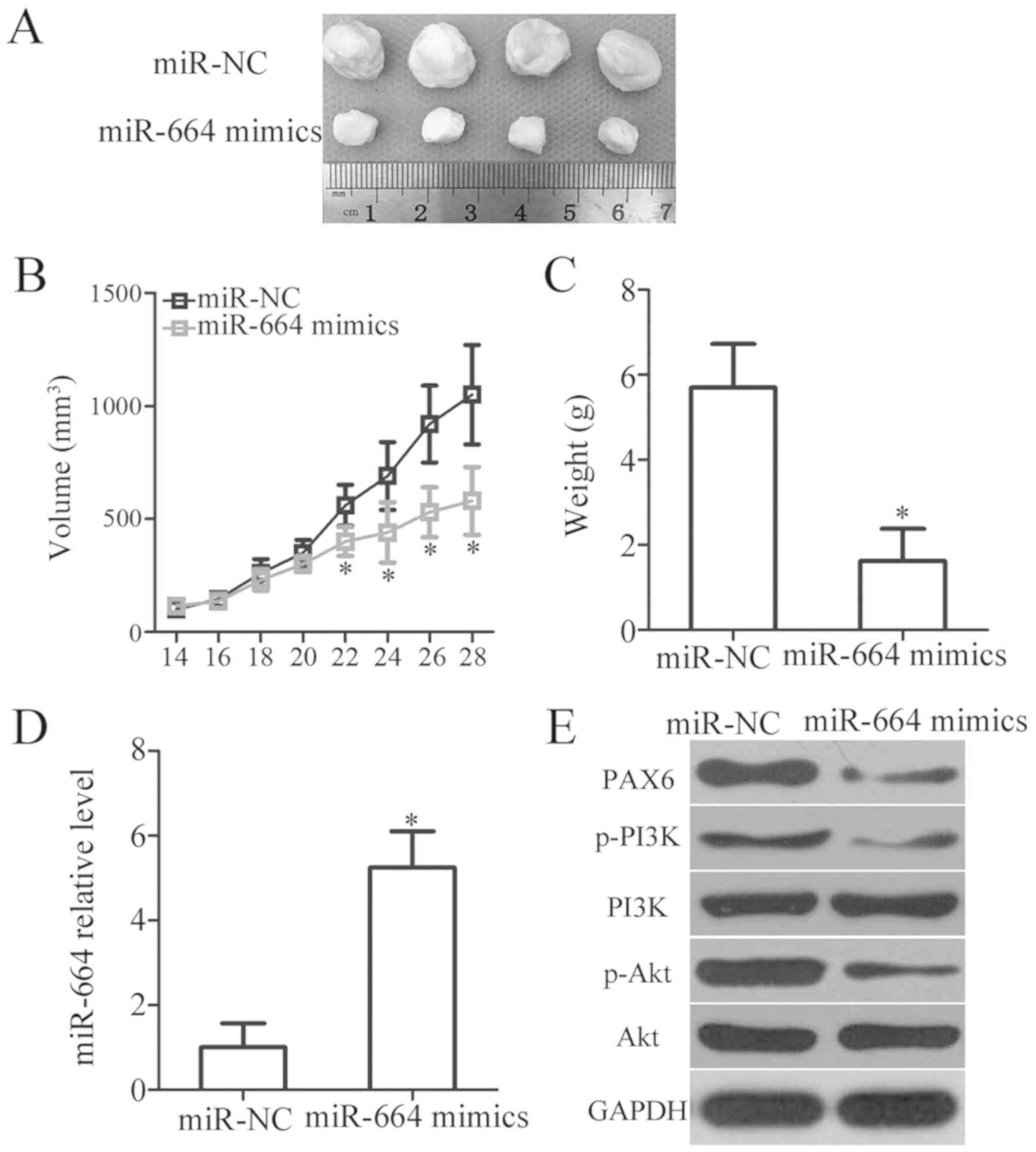|
1
|
Torre LA, Bray F, Siegel RL, Ferlay J,
Lortet-Tieulent J and Jemal A: Global cancer statistics, 2012. CA
Cancer J Clin. 65:87–108. 2015.
|
|
2
|
Garrido-Laguna I and Hidalgo M: Pancreatic
cancer: From state-of-the-art treatments to promising novel
therapies. Nat Rev Clin Oncol. 12:319–334. 2015.
|
|
3
|
Bussom S and Saif MW: Methods and
rationale for the early detection of pancreatic cancer. Highlights
from the ‘2010 ASCO Gastrointestinal Cancers Symposium’. Orlando,
FL, USA: Orlando, FL, USA. January 22-24–2010, JOP 11: 128–130,
2010.
|
|
4
|
Shahrokni A and Saif MW: Metastatic
pancreatic cancer: The dilemma of quality vs. quantity of life JOP.
14:391–394. 2013.
|
|
5
|
Kamisawa T, Wood LD, Itoi T and Takaori K:
Pancreatic cancer. Lancet. 388:73–85. 2016.
|
|
6
|
Siegel R, Ward E, Brawley O and Jemal A:
Cancer statistics, 2011: The impact of eliminating socioeconomic
and racial disparities on premature cancer deaths. CA Cancer J
Clin. 61:212–236. 2011.
|
|
7
|
Okui M, Yamamichi T, Asakawa A, Harada M
and Horio H: Resection for pancreatic cancer lung metastases.
Korean J Thorac Cardiovasc Surg. 50:326–328. 2017.
|
|
8
|
Wu H, Kong L, Zhou S, Cui W, Xu F, Luo M,
Li X, Tan Y and Miao L: The role of microRNAs in diabetic
nephropathy. J Diabetes Res. 2014:9201342014.
|
|
9
|
Kloosterman WP and Plasterk RH: The
diverse functions of microRNAs in animal development and disease.
Dev Cell. 11:441–450. 2006.
|
|
10
|
Szymczyk A, Macheta A and Podhorecka M:
Abnormal microRNA expression in the course of hematological
malignancies. Cancer Manag Res. 10:4267–4277. 2018.
|
|
11
|
He L and Zhang H: MicroRNAs in the
migration of mesenchymal stem cells. Stem Cell Rev. 15:3–12.
2019.
|
|
12
|
Xu X, Tao Y, Shan L, Chen R, Jiang H, Qian
Z, Cai F, Ma L and Yu Y: The role of MicroRNAs in hepatocellular
carcinoma. J Cancer. 9:3557–3569. 2018.
|
|
13
|
Delsin LEA, Salomao KB, Pezuk JA and
Brassesco MS: Expression profiles and prognostic value of miRNAs in
retinoblastoma. J Cancer Res Clin Oncol. 145:1–10. 2019.
|
|
14
|
Jamali L, Tofigh R, Tutunchi S, Panahi G,
Borhani F, Akhavan S, Nourmohammadi P, Ghaderian SMH, Rasouli M and
Mirzaei H: Circulating microRNAs as diagnostic and therapeutic
biomarkers in gastric and esophageal cancers. J Cell Physiol.
233:8538–8550. 2018.
|
|
15
|
Bryzgunova OE, Konoshenko MY and Laktionov
PP: MicroRNA-guided gene expression in prostate cancer: Literature
and database overview. J Gene Med. 20:e30162018.
|
|
16
|
Mikamori M, Yamada D, Eguchi H, Hasegawa
S, Kishimoto T, Tomimaru Y, Asaoka T, Noda T, Wada H, Kawamoto K,
et al: MicroRNA-155 controls exosome synthesis and promotes
gemcitabine resistance in pancreatic ductal adenocarcinoma. Sci
Rep. 7:423392017.
|
|
17
|
Li H, Xiang H, Ge W, Wang H, Wang T and
Xiong M: Expression and functional perspectives of miR-184 in
pancreatic ductal adenocarcinoma. Int J Clin Exp Pathol.
8:12313–12318. 2015.
|
|
18
|
Fan Y, Xu LL, Shi CY, Wei W, Wang DS and
Cai DF: MicroRNA-454 regulates stromal cell derived factor-1 in the
control of the growth of pancreatic ductal adenocarcinoma. Sci Rep.
6:227932016.
|
|
19
|
Cheng RF, Wang J, Zhang JY, Sun L, Zhao
YR, Qiu ZQ, Sun BC and Sun Y: MicroRNA-506 is up-regulated in the
development of pancreatic ductal adenocarcinoma and is associated
with attenuated disease progression. Chin J Cancer. 35:642016.
|
|
20
|
Zhu G, Zhou L, Liu H, Shan Y and Zhang X:
MicroRNA-224 promotes pancreatic cancer cell proliferation and
migration by targeting the TXNIP-mediated HIF1α pathway. Cell
Physiol Biochem. 48:1735–1746. 2018.
|
|
21
|
Fu Y, Liu X, Chen Q, Liu T, Lu C, Yu J,
Miao Y and Wei J: Downregulated miR-98-5p promotes PDAC
proliferation and metastasis by reversely regulating MAP4K4. J Exp
Clin Cancer Res. 37:1302018.
|
|
22
|
Li C, Dong Q, Che X, Xu L, Li Z, Fan Y,
Hou K, Wang S, Qu J, Xu L, et al: MicroRNA-29b-2-5p inhibits cell
proliferation by directly targeting Cbl-b in pancreatic ductal
adenocarcinoma. BMC Cancer. 18:6812018.
|
|
23
|
Ding Z, Jian S, Peng X, Liu Y, Wang J,
Zheng L, Ou C, Wang Y, Zeng W and Zhou M: Loss of MiR-664
expression enhances cutaneous malignant melanoma proliferation by
upregulating PLP2. Medicine (Baltimore). 94:e13272015.
|
|
24
|
Zhang YX, Qin LL and Yang SY:
Down-regulation of miR-664 in cervical cancer is associated with
lower overall survival. Eur Rev Med Pharmacol Sci. 20:1740–1744.
2016.
|
|
25
|
Fiala O, Pitule P, Hosek P, Liska V,
Sorejs O, Bruha J, Vycital O, Buchler T, Poprach A, Topolcan O, et
al: The association of miR-126-3p, miR-126-5p and miR-664-3p
expression profiles with outcomes of patients with metastatic
colorectal cancer treated with bevacizumab. Tumour Biol.
39:10104283177092832017.
|
|
26
|
Wu L, Li Y, Li J and Ma D: MicroRNA-664
targets insulin receptor substrate 1 to suppress cell proliferation
and invasion in breast cancer. Oncol Res. Mar 1–2018.Epub ahead of
print:10.3727/096504018X15193500663936.
|
|
27
|
Livak KJ and Schmittgen TD: Analysis of
relative gene expression data using real-time quantitative PCR and
the 2(-Delta Delta C(T)) method. Methods. 25:402–408. 2001.
|
|
28
|
Mascarenhas JB, Young KP, Littlejohn EL,
Yoo BK, Salgia R and Lang D: PAX6 is expressed in pancreatic cancer
and actively participates in cancer progression through activation
of the MET tyrosine kinase receptor gene. J Biol Chem.
284:27524–27532. 2009.
|
|
29
|
Diao J, Su X, Cao L, Yang Y and Liu Y:
MicroRNA 874 inhibits proliferation and invasion of pancreatic
ductal adenocarcinoma cells by directly targeting paired box 6. Mol
Med Rep. 18:1188–1196. 2018.
|
|
30
|
Li Y, Li Y, Liu Y, Xie P, Li F and Li G:
PAX6, a novel target of microRNA-7, promotes cellular proliferation
and invasion in human colorectal cancer cells. Dig Dis Sci.
59:598–606. 2014.
|
|
31
|
Huang BS, Luo QZ, Han Y, Huang D, Tang QP
and Wu LX: MiR-223/PAX6 axis regulates glioblastoma stem cell
proliferation and the chemo resistance to TMZ via regulating
PI3K/Akt pathway. J Cell Biochem. 118:3452–3461. 2017.
|
|
32
|
Li J and You X: MicroRNA 758 inhibits
malignant progression of retinoblastoma by directly targeting PAX6.
Oncol Rep. 40:1777–1786. 2018.
|
|
33
|
Passadouro M and Faneca H: Managing
pancreatic adenocarcinoma: A special focus in microRNA gene
therapy. Int J Mol Sci. 17:172016.
|
|
34
|
Yonemori K, Kurahara H, Maemura K and
Natsugoe S: MicroRNA in pancreatic cancer. J Hum Genet. 62:33–40.
2017.
|
|
35
|
Sun L, Chua CY, Tian W, Zhang Z, Chiao PJ
and Zhang W: MicroRNA signaling pathway network in pancreatic
ductal adenocarcinoma. J Genet Genomics. 42:563–577. 2015.
|
|
36
|
Frampton AE, Krell J, Jamieson NB, Gall
TM, Giovannetti E, Funel N, Mato Prado M, Krell D, Habib NA,
Castellano L, et al: microRNAs with prognostic significance in
pancreatic ductal adenocarcinoma: A meta-analysis. Eur J Cancer.
51:1389–1404. 2015.
|
|
37
|
Zhu H, Miao MH, Ji XQ, Xue J and Shao XJ:
miR-664 negatively regulates PLP2 and promotes cell proliferation
and invasion in T-cell acute lymphoblastic leukaemia. Biochem
Biophys Res Commun. 459:340–345. 2015.
|
|
38
|
Bao Y, Chen B, Wu Q, Hu K, Xi X, Zhu W,
Zhong X and Chen J: Overexpression of miR-664 is associated with
enhanced osteosarcoma cell migration and invasion ability via
targeting SOX7. Clin Exp Med. 17:51–58. 2017.
|
|
39
|
Chen B, Bao Y, Chen X, Yi J, Liu S, Fang
Z, Zheng S and Chen J: Mir-664 promotes osteosarcoma cells
proliferation via down-regulating of FOXO4. Biomed Pharmacother.
75:1–7. 2015.
|
|
40
|
Zhu X, Ju S, Yuan F, Chen G, Shu Y, Li C,
Xu Y, Luo J and Xia L: microRNA-664 enhances proliferation,
migration and invasion of lung cancer cells. Exp Ther Med.
13:3555–3562. 2017.
|
|
41
|
Yang Y, Liu H, Wang X and Chen L:
Up-regulation of microRNA-664 inhibits cell growth and increases
cisplatin sensitivity in cervical cancer. Int J Clin Exp Med.
8:18123–18129. 2015.
|
|
42
|
Fang Y, Zhang L, Li Z, Li Y, Huang C and
Lu X: MicroRNAs in DNA damage response, carcinogenesis, and
chemoresistance. Int Rev Cell Mol Biol. 333:1–49. 2017.
|
|
43
|
Meng Y, Zou Q, Liu T, Cai X, Huang Y and
Pan J: microRNA-335 inhibits proliferation, cell-cycle progression,
colony formation, and invasion via targeting PAX6 in breast cancer
cells. Mol Med Rep. 11:379–385. 2015.
|
|
44
|
Zhao Y, Lu G, Ke X, Lu X, Wang X, Li H,
Ren M and He S: miR-488 acts as a tumor suppressor gene in gastric
cancer. Tumour Biol. 37:8691–8698. 2016.
|
|
45
|
Zhao X, Yue W, Zhang L, Ma L, Jia W, Qian
Z, Zhang C and Wang Y: Downregulation of PAX6 by shRNA inhibits
proliferation and cell cycle progression of human non-small cell
lung cancer cell lines. PLoS One. 9:e857382014.
|
|
46
|
Li X, Yang L, Shuai T, Piao T and Wang R:
MiR-433 inhibits retinoblastoma malignancy by suppressing Notch1
and PAX6 expression. Biomed Pharmacother. 82:247–255. 2016.
|
|
47
|
Xia X, Yin W, Zhang X, Yu X, Wang C, Xu S,
Feng W and Yang H: PAX6 overexpression is associated with the poor
prognosis of invasive ductal breast cancer. Oncol Lett.
10:1501–1506. 2015.
|
|
48
|
Wolin EM: PI3K/Akt/mTOR pathway inhibitors
in the therapy of pancreatic neuroendocrine tumors. Cancer Lett.
335:1–8. 2013.
|
|
49
|
Baer R, Cintas C, Therville N and
Guillermet-Guibert J: Implication of PI3K/Akt pathway in pancreatic
cancer: When PI3K isoforms matter? Adv Biol Regul. 59:19–35.
2015.
|















